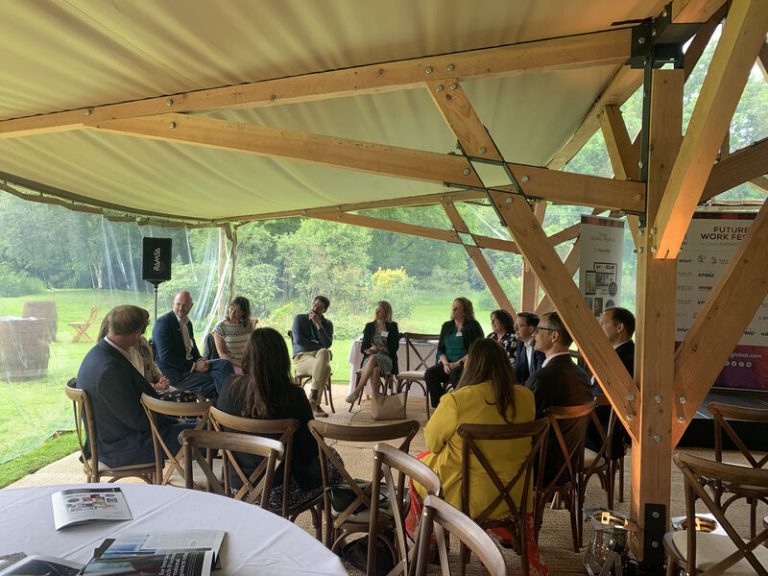
“Leadership is about being better able to listen to the whole than anyone else can”
Otto Scharmer (2009) Theory U: Learning from the Future as It Emerges
Co-authored with Edward L. Rowland
During these times of upheaval, the need to move forward in alignment with others has never been greater. The leadership challenges of today are too complex for any one person to solve alone. In our rapidly changing, increasingly uncertain and globally networked world, leadership needs to be less about individual heroics and more about listening to – and mobilising – collective potential.
Developing the skillset of what we call ‘systemic dialogue’ is critically important for leaders and their teams, whether they want to create a new vision, implement a new strategy or shift their performance. We define systemic dialogue as:
The artform and skillset of holding powerful meeting spaces to navigate critical business challenges and find solutions that strengthen the system as a whole.
In this article we explore three dimensions of systemic dialogue by:
- Outlining why a systemic approach is becoming increasingly critical in the current context of silo working and globalized business.
- Identifying the core capacities that leaders need to develop to meet the business challenges of today in a sustainable way.
- Sharing a practical example of how a global team successfully transitioned from the trap of operating in separate units (or “silos”) to working as a unified whole, using systemic dialogue.
The limitations of silo working
Many of us have experienced the frustration of working in organisations where rivalry between departments undermines collective performance, infighting between divisions creates unhealthy in-house competition and lack of communication causes blindspots that could have been avoided.
Gillian Tett, a writer at the Financial Times, has recently published her new book The Silo Effect. By looking at the root cause of great financial crisis in 2008, she explores both the upside and downside of silo-isation. Division of labour, the hallmark of our market economy, has led to benefits, at least in the short-term. Tett highlights how highly structured Sony, for example, in the 1970s, was a leading light for innovation with its Walkman and Trinitron TV. Specialization can, at times, lead to improve efficiency, increase profits and generate a greater sense of control.
Silo-working has, however, now become so taken-for-granted that we may miss seeing its dark side. As we become buried in our corner of the organization or immersed in our specialism, we are more likely to develop tunnel vision. Dividing an organization, and its people, into “departments”, “divisions” and “units” (the language itself is revelatory) has the unintended impact of stopping collaboration in its tracks. Despite our interconnectedness – news can flash across the planet at lightening speed – our lives and organisations are “crazily fragmented”, according to Tett.
Working alongside each other rather than with each other, can lead to damaging consequences for a system as a whole. Tett highlights how in the UK the government, banks and regulators failed to spot the emerging financial crisis. With more dialogue between diverse stakeholders, the catastrophic consequences of the banking crisis may have been avoided. The constraints of the mental models used by economists, who typically assume efficient markets and rational expectations, were not critically reflected upon. Tett concludes that financial institutions are not just about economics: “Culture matters too.”
Capacities for co-creating change
To seed a new culture of aligned action, energetic engagement and collaboration across boundaries, many different capacities are needed. These are set out in the diagram below. We have articulated six core capacities, arising out of our combined expertise of working with leaders using generative dialogue, systemic coaching and constellations, Otto Scharmer’s Theory U and mindfulness practice, as well as recent business school and scientific research.
Developing these six capacities enables teams to stop operating in silos and work as a unified collective, even if they are widely distributed geographically.
A Case Study
What follows is how we helped a global leadership team to start to develop these core capacities in a practical way – particularly the ‘outer’ four skills outlined in the diagram – as part of an off-site team development session.
The capacity-building session was for a group of around 30 individuals, with highly diverse cultural backgrounds, who worked in local operations teams in all corners of the world. Their goal was to provide excellent global execution across multiple time zones. Even picking up the phone to resolve an issue was a day-to-day challenge given the 11-hour time difference between some of the teams.
(1) Creating the conditions for generative dialogue
At the start of the meeting, instead of getting down to business straight away, we took time to meet as fellow human beings. This set a respectful, friendly and informal tone to the meeting. When people were asked to name a person or a leader who had inspired them, some mentioned formal leaders but most spoke of family members – their partner, parent or grandparent. Inviting all the different voices set a pattern of full participation, which was then sustained through the session.
Research by psychologists at the MIT Sloan School of Management in the US throws some light on how collective intelligence emerges in a group. In an article originally published in Science in October 2010 several factors were found to be associated with collective effectiveness. It is also worth noting what wasn’t related: the average IQ of the group, the IQ of the smartest member and the size of the group. Instead, the researchers found that groups were more likely to perform well if three factors were present:
- Conversational turn-taking – Groups with a more even pattern of participation outperformed groups where one or two individuals dominated.
- Social sensitivity – In the higher performing groups, individuals were more accurately able to discern what others were thinking and feeling by paying attention to their body language, facial expressions and other non-verbal cues.
- A higher proportion of women – The more women in a group, the more likely it was to perform well. This result might be because the women in the sample scored better on the social intelligence measure.
As practitioners, what excites us about these findings is that we can co-create the conditions where these factors come into play. As the psychologists highlight, “It would seem to be much easier to raise the intelligence of a group than an individual.” One simple way to do this is to sow the seed for healthy conversational turn-taking by enabling everyone to find their voice early on.
(2) Seeing the larger system
The second intervention we made was to create two different “maps” where people stood in different places in terms of:
- Office location
- Number of years with the organisation
To create the first map, we placed eleven pieces of flip chart paper on the floor to represent the eleven local offices. The layout reflected as closely as possible the global geography. It was striking how far apart the teams in Singapore and Argentina were from one another. The mapping enabled the teams to speak openly and non-defensively about the challenge of working across time zones and their tendency to engage in lengthy email exchanges rather than pick up the phone and talk.
When asked to describe the atmosphere in their local office, the range of responses was telling. Some teams were “happy”, “noisy” and “commercial” but others were “silent” and “stressed.” The more isolated teams were geographically, the more they appeared to be struggling. Making this invisible dynamic visible led to a powerful group dialogue about how difficult it was to find a mutually convenient time to talk. Having named the problem, the different teams went on to identify the windows of time when it would be possible to talk.
The second map made visible the range of length of service: from 20 years to 6 months. People listened carefully to the reasons that the longest serving members gave when they were asked what kept them in the organisation. The conversation that unfolded while people were stood on their feet brought not only respect but humour too. When asked what had drawn those who were new to the organisation “in one word”, their answers included “Diversity”, “Opportunity” and “Money!”
Acknowledging those who had been around the longest not only settled the group but also helped the group later in their dialogue. The two individuals who had served the longest were not the most senior. They did however bring a valuable perspective that more recent arrivals could not have contributed. One of the “old timers” began sharing a key insight by saying, “From the 20 year perspective…” Mapping the system in this way helped her to find her voice and authority more easily – and be listened to.
(3) Attuning to higher potential to enable a clear direction to emerge
Later in the session, colleagues from different local offices self-organised into mixed groups to discuss their challenges and aspirations, and crystallise the path forward. These small groups of individuals, who had to work together but who rarely got the opportunity to meet face-to-face, were asked to practise active listening. They had to play back what they’d heard and check their understanding before they asserted their own opinion. It was also an opportunity to practise “social sensitivity” by picking up what was not being said but communicated non-verbally by body language and tone of voice.
When we heard some reflections in the whole group, people spoke of seeing “common ground”, not only in the issues they faced but, more powerfully, in their feelings about the team and its purpose. The earlier work we had done to map the team and reveal problematic patterns helped the team to see the big picture rather than stay stuck in feelings of being excluded. Indeed, they could now express their wish to belong (a key systemic ordering principle).
As the dialogue unfolded, people spoke passionately about their desire to become a high performing, flawlessly executing global team. It was clear that the team’s strong sense of purpose was acting like a ‘magnet’ to draw them together, and charge the field for the next chapter of the team’s potential. In an atmosphere of openness and curiosity, a deeper level of frustrations between the local offices were named and aired and cleared. Achievements were also acknowledged and shared.
One team member said how she felt “touched” by how the whole team was working together to meet the problems that lay in their midst. By taking time to slow down and really listen to each other, there was a palpable sense of “we’re all in this together.” A clear sense of direction for the team emerged from this shared attunement.
(4) Co-creating a new reality through greater collaboration and aligned action
By the end of the day, an expansive emotional space had opened up, tricky business issues had been discussed, and next steps had been agreed. Given the size of the global operations this team managed and the amount that they invoiced clients each week – several million dollars – increasing their group functioning and strategic alignment in this way would have a massive impact on the amount of working capital available. Investing in ‘soft’ (critical) skills has its tangible, hard edge.
In closing
It takes time, energy and investment to create the conditions where a whole team perspective emerges. Meeting face-to-face, valuing all the different voices and strengthening relationships improves collaboration, dissolves silos and empowers the whole, leading to truly excellent performance.
Interested in finding out more?
We are running a 2-day programme in London on 9th-10th November 2016 on Leading Systemic Dialogue: Unlocking Collective Intelligence.
To find out more, please click: http://goo.gl/9XYD0S
We are also shortly publishing a free ebook on Systemic Dialogue, which will be available for download from our website (http://wholepartnership.com) later in the summer.






